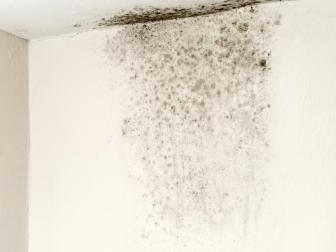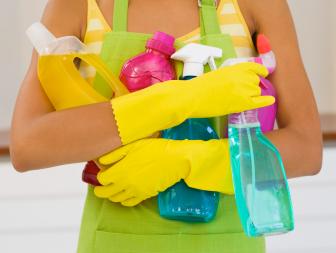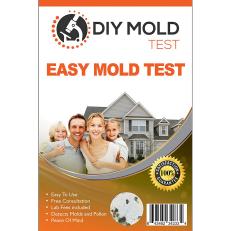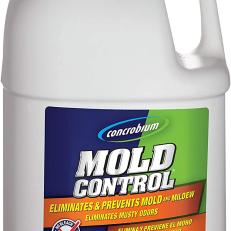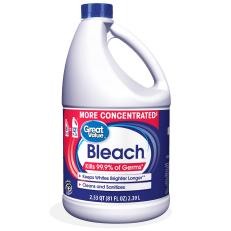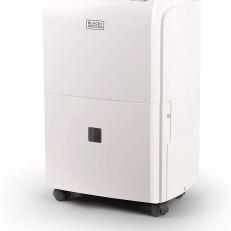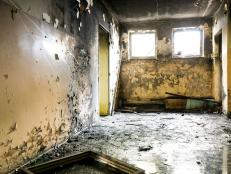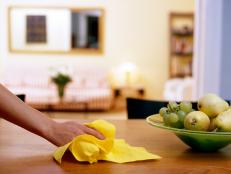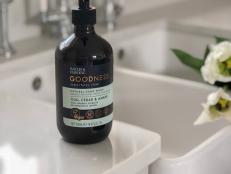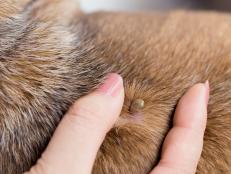How to Identify and Remove Mold in Your Home
Learn about the different types of mold and mildew, how to get rid of them and how to safeguard your home from this dirty fungus.
What is Mold?
Mold is a type of fungus that grows both indoors and outdoors and thrives on moisture. Mold sprouts from tiny spores that float about in the air and settle on moist surfaces, where they reproduce into mold colonies. There are thousands of types of molds all over the world, most of them harmless. But some mold becomes a problem when it impacts the integrity of your home. Some molds are also toxic and may affect your health.
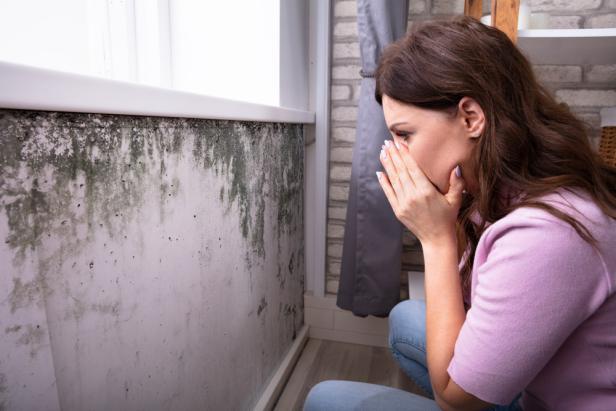
Shutterstock/Andrey_Popov
If mold is present in your home, you might begin to notice a damp, musty odor in a specific area. It’s commonly found in bathrooms, basements and kitchens. If you notice a musty odor, you should check for damp walls, carpet, flooring and any other spaces that may be breeding grounds for mold. The key is to treat a mold problem immediately, before the infestation becomes worse or causes permanent damage.
Common Areas for Mold Growth
Learn the most common areas for mold in your house, and take steps to safeguard against mold growth.
Types of Mold
Mold comes in a variety of hues, including black, white, green and orange. The most common types of mold include aspergillus, cladosporium and stachybotrys chartarum (also known as black mold). Aspergillus is a fairly allergenic mold that is commonly found on foods and in-home air-conditioning systems. Cladosporium is typically a black or green "pepper like" substance that grows on the back of toilets, painted surfaces and fiberglass air ducts. While this mold is nontoxic to humans, it can trigger common allergy symptoms such as red and watery eyes, rashes and a sore throat.
Mold that appears to be orange or red in color is typically found outdoors, given its nature to thrive on decaying plants or moist wood. This type of mold, which can appear slimy, is harmless and should only be removed for aesthetic purposes.
White mold is not technically a type of mold, but the good news is that this typically indicates the mold is only in the early stages of growth and can easily be treated.
Mold vs. Mildew
Homeowners often refer to mold and mildew interchangeably, but it’s important to distinguish mildew from mold. Mildew is a common type of mold that sits on the surface of damp walls, doors, shower grouting and more. This type of mold looks like tiny black spots that have a flat, sometimes powdery appearance. Mold is a broader term that refers to many mold species. It can be green, black or red, and often feels slimy. “Mold is typically more serious and costly to remediate than mildew,” says Jennifer Rodriguez, chief hygiene officer for Pro Housekeepers. Whereas mildew can easily be scrubbed away with a cleaning brush and store-bought mold killer, mold is often more stubborn and may require extra steps or professional remediation to remove.
How to Identify Mold vs. Mildew in Your Home
Mold and mildew are definitely fungus brothers, but they do have a few striking differences. Learn more about the ins and outs of the two with this guide.
How to Test for Mold
One of the best tried-and-true methods of testing for mold is by simply letting your nose do the sniffing. Most often, a mold problem will be readily identified by a musty smell that becomes obvious in damp environments. Mold also likes to play hide and seek, so if you suspect there is a problem, then check under carpets, behind drywall, inside ductwork, in between bathroom tiles and in other moisture-prone areas. David Ragsdale, production manager at SERVPRO Headquarters, says other signs of possible moisture buildup is bubbled paint, uneven hardwood flooring or discoloration of finished surfaces.
If you prefer a formal test, then consider a home testing kit. Home testing kits are typically petrie dishes that you place in a location where you suspect harmful mold might be growing. The dish is meant to collect spores over the course of 24 to 48 hours and then grow the spores into mold, which is then evaluated by a lab or visually inspected. Home test kits are limited in what they can tell you and typically merely inform you if molds are present. From there, you can hire a professional to conduct a more thorough evaluation of the type of mold and where it’s located. Keep in mind that mold testing can be inconclusive or unnecessary, especially if you already smell the mold.
If you are considering hiring a pro to help locate a mold problem within your home, it's important to know just how much a mold inspection costs. Because mold infestations can greatly vary in size, the cost of a mold inspection can, too. In fact, the running total for an expert to examine your home can range anywhere from $400 to $3,000.
Some companies will offer free mold inspections, but keep in mind that they often offer their services free of charge because they are hoping you will employ them if mold is detected. A useful tip for helping to cut the cost of a mold inspection is to prepare ahead of time any questions you might have and to be ready to point out your areas of concern. This will help subtract a bit of time off the length of their stay and save you some money.
When you are choosing a mold inspector, be sure to research the companies you are thinking of selecting. Ask neighbors or friends for recommendations, and don't hesitate to ask questions when calling a company to inquire about their services.

How to Remove Mold
Some mold is quick and easy to clean, merely requiring a regular wipe down around the tub or window, but sometimes professionals are needed. “The general dividing line between homeowner clean up versus professional remediation is whether the mold is covering under or above 10 square feet,” says Ragsdale. You may also need to hire a professional if your drywall is covered in mold or if you are allergic to mold.
In order to get rid of a major mold problem, you must remove the mold and remedy the moisture problem that caused the excessive mold growth in the first place. Ragsdale highly recommends immediately fixing the cause of the moisture problem that led to the mold, whether it’s bad plumbing, a leak, or excessive humidity. “Mold requires moisture, so if the moisture intrusion is not corrected, cleaning efforts may be in vain,” says Ragsdale.
When cleaning mold on your own, be sure to wear gloves, goggles and N-95 respirator masks to reduce your exposure to the mold. If there are outdoor openings in the room, place an exhaust fan near them to help remove mold spores from the room. If the moldy area is dry, lightly spray with water, as this will reduce the incidence of airborne mold spores during cleaning.
For non-porous surfaces, such as counters, cabinets and vanities, you may simply wipe down with water and dish detergent to remove the mold. Use a stiff scrub brush for durable surfaces and a cloth or sponge for more delicate surfaces. Let the area dry completely. If the surface is more porous or absorbent, such as drywall or ceiling tiles, Rodriguez recommends spraying and scrubbing the surface with a 50/50 solution of white vinegar and 3% hydrogen peroxide. However, if the mold is too stubborn, you may need to cut out the infected areas.
Place all used sponges, equipment and other materials in a heavy-duty garbage bag, and if possible, remove the bag through a nearby exit as opposed to the main house to avoid distributing mold spores.
Mold Removal and Remediation
If you've spotted mold in your home, it's time to fight it fair and square. Use these mold removal tips and kiss that nasty fungus goodbye.
How to Prevent Mold
Mold flourishes in warm, moist areas, so the key to mold prevention is controlling moisture buildup in your home. “Controlling the humidity in your home and addressing leaks or water intrusions as soon as possible is the primary way to prevent mold,” says Ragsdale. If you notice any water leaks, act quickly to fix the leak. If your indoor humidity levels run high, you may want to invest in a dehumidifier or air conditioner to better control the humidity. Ragsdale recommends servicing your HVAC system annually to ensure it is doing its job at controlling humidity buildup. Crawl spaces and basements are common locations for mold growth, says Rasgdale, since they are typically not climate controlled. If you cannot ventilate these areas, you may need to install a dehumidifier. Ragsdale also recommends being mindful of how you store items in these areas. For example, a pile of newspapers or magazines can soak up moisture in humid spaces and make excellent breeding grounds for mold.
Bathrooms are also hotbeds for mold growth, so be sure to run the fan or open a window during showers or baths. In addition, take care to wipe down surfaces in your shower stall to prevent mold growth. Sometimes mold grows in areas of the shower where water becomes trapped or takes a while to dry out, such as gaskets or shower door tracks. In these cases, take extra time to ensure these areas are properly dried out.
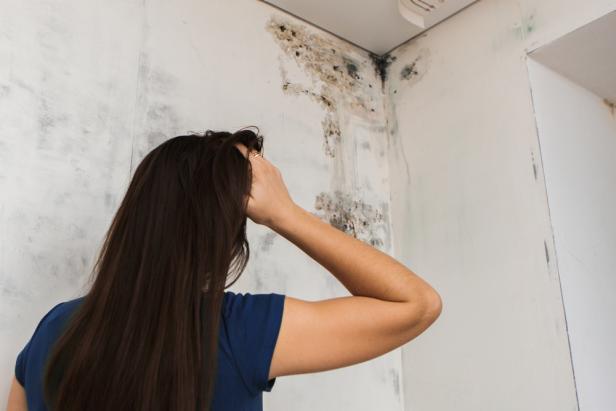
Shutterstock/Burdun Iliya
Symptoms of Mold Exposure
While many are harmless, certain molds can harm your health by producing allergens or even toxins. Typical symptoms of mold exposure include sneezing, runny nose, congestion, rashes and irritation to the eyes, nose, throat and even lungs. If you have asthma, mold can potentially trigger an asthma attack.







